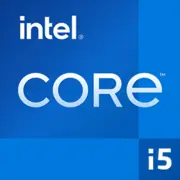Intel Core i5-1235U

Intel Core i5-1235U: A Versatile Processor for Mobility and Performance
March 2025
Laptop processors have long ceased to be a compromise between power and battery life. The Intel Core i5-1235U is a prime example of a modern chip that combines the hybrid Alder Lake architecture, energy efficiency, and sufficient performance for most tasks. Let's explore who this CPU is suited for, how it performs in real-life scenarios, and what to pay attention to when purchasing a device based on it.
Architecture and Process Technology: Hybrid Approach and Iris Xe Graphics
Hybrid P-Core and E-Core
The Core i5-1235U is built on the Alder Lake architecture (Intel 7 process technology, previously known as 10nm Enhanced SuperFin). It includes 2 performance cores (P-Core) with Hyper-Threading support (4 threads) and 8 efficient cores (E-Core) without multi-threading. In total, there are 10 cores and 12 threads.
- P-Cores operate at a base frequency of 1.3 GHz but can reach 4.4 GHz in Turbo Boost mode. They handle resource-intensive tasks such as rendering, video encoding, and running heavy applications.
- E-Cores function at frequencies up to 3.3 GHz and are optimized for background processes like system updates, music streaming, and messaging app operations.
This division allows for battery savings without sacrificing system responsiveness. For instance, while editing a document in Word, P-cores activate for instant responses, while E-cores manage cloud synchronization.
Iris Xe Graphics: More Than Just Office Use
The integrated GPU Iris Xe (96 EU) supports DirectX 12, 4K displays, and AI acceleration technologies. In gaming, it shows modest but practical results:
- CS:GO — 60–70 FPS at 1080p with low settings;
- Fortnite — 45–50 FPS at 720p;
- Genshin Impact — 30–35 FPS (720p, minimum settings).
For less demanding projects and cloud gaming (such as Xbox Cloud Gaming), this is sufficient. However, by 2025, Iris Xe struggles with new AAA titles even at minimum settings.
Power Consumption and TDP: A Balance Between Power and Battery Life
The nominal TDP of the processor is 15 W, but in turbo mode, consumption can reach up to 55 W. However, ultrabooks typically have cooling systems designed for 25–30 W, limiting runtime at maximum frequencies.
Energy-Saving Technologies:
- Intel Dynamic Tuning 3.0 — automatically switches between performance and power-saving modes based on workload.
- Speed Shift — instantly adjusts core frequencies to reduce latency.
- Deep Learning Boost — accelerates AI tasks (such as noise suppression in Zoom) with minimal energy consumption.
In practice, this means that in “Battery Saver” mode, a laptop with an i5-1235U can last up to 10–12 hours while web surfing, but during active video rendering, that time drops to 2–3 hours.
Performance: Real Tests and Turbo Mode
Office and Multimedia
- Geekbench 6: 1860 (Single-Core), 5735 (Multi-Core). For comparison, the Core i5-1135G7 (2020) scored 1450/4300.
- Running 30 tabs in Chrome + YouTube 4K: the processor maintains stability without overheating (temperature up to 65°C).
- Adobe Photoshop (2025): processing RAW photos takes 20% less time than the previous generation.
Gaming and Turbo Mode
In gaming, Turbo Boost activates P-cores at 4.4 GHz, but after 10–15 minutes, the frequency drops to 3.8–4.0 GHz due to overheating. For example, in Rocket League (1080p, medium settings), FPS remains around 50–55, but after 20 minutes, it decreases to 40–45.
Advice: For stable gaming, choose laptops with dual-fan cooling, such as MSI Modern 14 or Lenovo Yoga Slim 7 Pro.
Usage Scenarios: Who Is the i5-1235U Suitable For?
1. Students and Office Workers — fast document editing, Zoom conferencing, multitasking.
2. Digital Artists — drawing in Photoshop, light 3D modeling in Blender.
3. Travelers — compact ultrabooks weighing from 1.2 kg with long battery life.
4. Casual Gamers — games like Dota 2 or Stardew Valley.
Comparison with Competitors
AMD Ryzen 5 7530U
- Pros: 6 Zen 3 cores, better multi-threading (Geekbench Multi-Core ~6100), integrated Vega 7 graphics.
- Cons: Lower Single-Core (1700), no Thunderbolt 4 support.
- Price: Laptops starting from $650 (e.g., HP Envy x360 13).
Apple M2
- Pros: record battery life (up to 18 hours), cool operation.
- Cons: limited compatibility with Windows software, high price (laptops starting from $1100).
Intel Core i5-1235U vs. Previous Generations
- Single-Core performance is 25% higher than the i5-1135G7;
- Power consumption is 15% lower than the i5-11300H.
Pros and Cons
Strengths:
- Ideal for thin laptops;
- Supports Thunderbolt 4 and Wi-Fi 6E;
- Good price (devices from $700).
Weaknesses:
- Limited power headroom for rendering;
- Heating under prolonged loads;
- Iris Xe graphics becoming outdated for modern games.
Laptop Selection Recommendations
1. Type of Device: ultrabooks (Acer Swift 5), business laptops (Dell Latitude 5430).
2. Cooling: at least 1 fan + copper heat pipes.
3. Display: IPS matrix with 300 nits brightness and 1080p+ resolution.
4. Ports: 2x Thunderbolt 4, HDMI 2.0, USB-A.
Examples of 2025 Models:
- Asus ZenBook 14 UX425 ($799): weight 1.1 kg, battery life 13 hours.
- Lenovo ThinkPad X1 Carbon Gen 11 ($1299): premium build, moisture protection.
Final Conclusion
The Intel Core i5-1235U is an optimal choice for those seeking a balance between mobility and performance. It is suitable for:
- Work: office tasks, web development, light design.
- Study: online courses, working with graphs and presentations.
- Entertainment: streaming, older games, multimedia consumption.
Key Benefits:
- Modern architecture with hybrid cores;
- Support for current connectivity standards;
- Affordable price in the ultrabook segment.
If you don't need extreme power for 3D rendering or 4K gaming, the i5-1235U will be a reliable companion for the next 3–4 years.
Basic
CPU Specifications
Memory Specifications
GPU Specifications
Miscellaneous
Benchmarks
Compared to Other CPU
Share in social media
Or Link To Us
<a href="https://cputronic.com/en/cpu/intel-core-i5-1235u" target="_blank">Intel Core i5-1235U</a>





